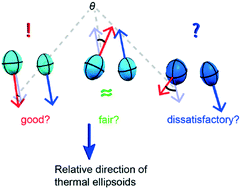A new tool for validating theoretically derived anisotropic displacement parameters with experiment: directionality of prolate displacement ellipsoids†
Abstract
X-ray diffraction on crystalline solids provides the electron density in the unit cell, typically interpreted as atom types, fractional coordinates, and anisotropic displacement parameters (ADPs). Given the chemical composition, not only coordinates but also ADPs can be obtained from first-principles calculations. In order to validate the latter, we suggest comparing the direction of the maximum main axes for sufficiently anisotropic theoretical and experimental ellipsoids, in addition to their scalar properties. This new criterion provides additional insight: while the amplitude of motion is generally underestimated by the computationally inexpensive harmonic approximation, the relative orientation may still be in good agreement with the experimental findings. This approach can complement the already established scatter plot of main-axes components and the similarity index, and it is also chemically intuitive by giving a direct picture of the relative orientation of the ellipsoids.



 Please wait while we load your content...
Please wait while we load your content...